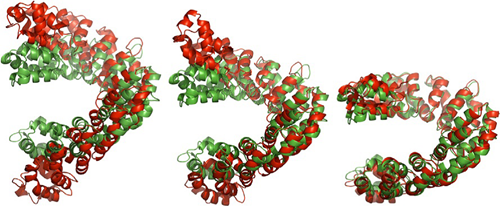Recently, a research team led by Prof. LEI Hongxing at Beijing Institute of Genomics, Chinese Academy of Sciences (BIG), conducted computational analyses on the conformational elasticity and specific recognition of TALEs (transcription activator-like effector), and novel insights regarding the binding mechanism were gained from the MD simulations of the DNA-free TALE. Sequence-programmable TALE proteins have emerged as a highly efficient tool for genome engineering. However, recent crystal structures depict a transition between an open unbound solenoid and more compact DNA-bound solenoid formed by the 34 amino acid repeats. How TALEs switch conformation between these two forms without substantial energetic compensation, and how the repeat-variable di-residues (RVDs) discriminate between the cognate base and other bases still remain unclear. Towards this end, Prof. LEI and his research team conducted computational analyses on these two aspects of TALE–DNA interaction mechanism in order to achieve a better understanding of the energetics. High elasticity was observed in the molecular dynamics simulations of DNA-free TALE structure that started from the bound conformation where it sampled a wide range of conformations including the experimentally determined apo and bound conformations. This elastic feature was also observed in the simulations starting from the apo form which suggests low free energy barrier between the two conformations and small compensation required upon binding. To analyze binding specificity, the researchers also performed free energy calculations of various combinations of RVDs and bases using Poisson–Boltzmann surface area (PBSA) and other approaches. The PBSA calculations indicated that the native RVD–base structures had lower binding free energy than mismatched structures for most of the RVDs examined. Prof. LEI indicated that “Our theoretical analyses provided new insight on the dynamics and energetics of TALE–DNA binding mechanism.” Three representative snapshots from the MD simulation trajectory are shown. The structures from the simulation are shown in red and the reference bound structure is shown in green. (Image by LEI's group) 
